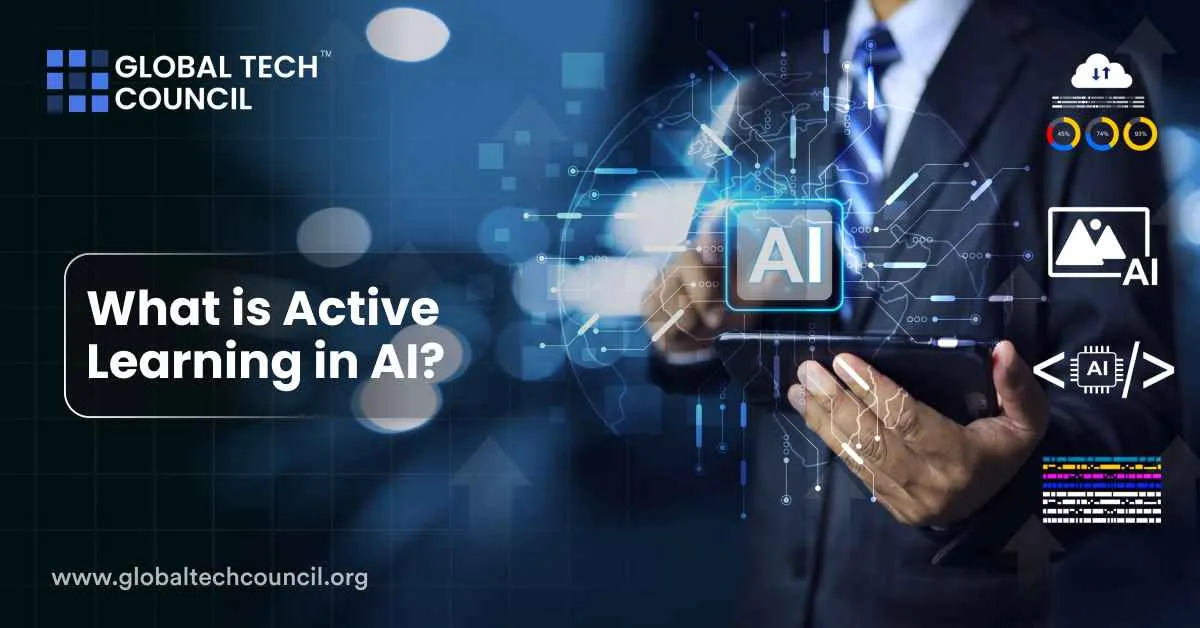
This approach is especially useful when labels are expensive, such as in medical imaging or legal documents. It’s also becoming a core part of modern AI workflows that involve human feedback or expert annotation.
In this article, you’ll learn how Active Learning works, why it’s important, where it’s used, and how it compares with traditional data labeling methods.
How Active Learning Works
Active Learning follows a simple process:
- Start with a small set of labeled data.
- Train a model using this initial dataset.
- Use the model to scan a larger pool of unlabeled data.
- Select only the most uncertain or informative examples.
- Ask a human expert to label those selected samples.
- Add the new labels to the dataset and retrain the model.
- Repeat the process until the model performs well.
This process is known as human-in-the-loop learning, where the AI model actively involves humans only when needed.
Key Strategies in Active Learning
There are several strategies to choose the next best samples to label:
Common Active Learning Strategies
| Strategy | How It Works | When It’s Useful |
| Uncertainty Sampling | Selects examples with the lowest model confidence | General use cases with probabilistic models |
| Query by Committee | Uses multiple models to find disagreements | Tasks where diverse models are available |
| Expected Model Change | Picks samples that would most change the model’s predictions | When model improvement is the top goal |
| Density-Weighted Sampling | Combines uncertainty with sample density in feature space | When rare but important cases exist |
Each strategy helps the model learn smarter, not harder.
Benefits of Active Learning
Active Learning offers multiple advantages, especially when resources are limited:
- Reduces the amount of labeled data needed
- Speeds up model development
- Focuses expert effort on the hardest examples
- Improves performance with fewer iterations
It’s also useful for teams working with niche data or limited budgets.
Limitations to Consider
Despite the advantages, Active Learning is not a one-size-fits-all solution. Some challenges include:
- Needs reliable experts to provide labels
- May struggle with noisy data or unclear class boundaries
- Requires infrastructure to manage data selection, annotation, and retraining
Still, these are often manageable with modern tools and workflows.
Where Active Learning Is Used
This method works best in domains where labeling is costly, but unlabeled data is easy to collect. Some of the most common industries include:
- Healthcare: For diagnosis and imaging tasks
- Finance: For fraud detection and compliance checks
- Retail: For product tagging and personalized recommendations
- Legal: For document review and contract classification
- Robotics and Vision: For object detection and edge-case identification
Use Cases of Active Learning in Real Projects
| Industry | Application | Value Provided |
| Medical Imaging | Labeling rare tumor images | Reduces radiologist workload |
| Legal Tech | Sorting legal documents for review | Speeds up contract analysis |
| Finance | Identifying rare fraud patterns | Improves detection without excess labels |
| Retail | Classifying customer behavior | Reduces data labeling cost |
| Robotics | Training vision models for rare cases | Helps improve safety in automation |
This shows how the technique helps across both public and private sectors.
Active Learning vs Traditional Supervised Learning
In supervised learning, teams label a large dataset before training the model. This can be wasteful, especially if many of the samples are easy or repetitive.
In Active Learning, you only label what matters.
Active Learning vs Supervised Learning
| Feature | Active Learning | Traditional Supervised Learning |
| Labeling Approach | Selective, model-guided | Label everything up front |
| Data Efficiency | High | Low |
| Cost | Lower (fewer labels needed) | Higher (labeling entire dataset) |
| Human Involvement | On-demand expert feedback | Mass annotation, often outsourced |
| Model Performance | Improves quickly with fewer samples | May plateau without large data volumes |
This comparison makes it clear why Active Learning is preferred in many real-world use cases.
How to Get Started with Active Learning
If you’re working on an AI project, you can begin with a simple pipeline:
- Start with 100–500 labeled samples.
- Train your model using any standard ML framework.
- Use uncertainty sampling to select the next batch.
- Label the selected data through internal teams or external experts.
- Retrain and repeat.
Tools like Encord, Snorkel, and custom Python scripts can help automate this cycle. You’ll also need to manage versions of your labeled data and monitor improvements at each step.
Why Active Learning Is Growing
Active Learning is becoming more important as AI moves into high-stakes domains like healthcare and finance. In these fields, expert time is limited, and quality matters more than quantity.
This method is also ideal for small teams building high-impact systems. By labeling fewer but better examples, even simple models can deliver strong results.
If you’re looking to grow your career in AI, it’s smart to gain hands-on experience with human-in-the-loop systems. You can start by exploring a Data Science Certification or dive deeper with Deep tech certification from Blockchain Council. Business teams can also explore the Marketing and Business Certification for AI use in content and customer workflows.
Final Takeaway
Active Learning lets AI models learn faster by focusing only on the data they truly need. It cuts costs, improves speed, and delivers better accuracy with fewer resources.
For teams working on custom applications, it’s one of the best ways to scale high-quality AI while keeping labeling work under control. It’s a practical technique with growing impact across industries.
If you’re working with limited data or expert time, Active Learning may be the smartest way forward.